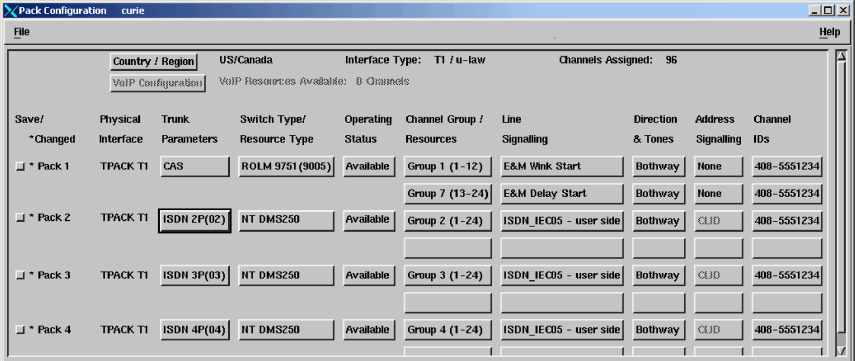An ISDN NFAS system can be configured with channel associated signaling (CAS) or common channel signaling (CCS) trunks also present, although this configuration is not usual.

You can define up to four NFAS groups with a maximum of 10 trunks in each. For each NFAS group you need to specify one primary trunk to carry the signaling for all the trunks in the NFAS group. Channel 24 on the primary trunk becomes a D-channel carrying signaling information and all other channels in the group become B-channels carrying voice.
For some switches and line signaling protocols you can also specify a backup trunk, see Blueworx Voice Response for AIX: General Information and Planning for a list of switches and protocols that have the D-channel backup facility enabled. If the primary D-channel goes out of service or becomes alarmed, a backup D-channel in standby mode will automatically take over the transport of signaling information. The backup D-channel does not carry voice.
All trunks
You must specify the same Switch Type and Line Signaling values for each trunk.
Each trunk must have a unique trunk identifier, which is specified in your switch configuration and must be matched correctly in the Trunk Interface Parameters window for each trunk (see Non Facility Associated Signaling (NFAS) support). The trunk identifiers are the numbers that are shown in parentheses on the Trunk Parameters buttons.
Removing or adding adapters can change the way trunks are numbered. Make sure your configuration identifies the correct physical trunks.
The primary and backup trunks
In Figure 1, pack 3 is identified as the primary trunk by a P on its Trunk Parameters button. The backup trunk is identified by a B.
For the primary and backup signaling trunks, B8ZS Line Code and ESF Framing Mode are automatically set because these are the only valid options (see T1 line code, framing mode, and framing format).
The non-signaling trunks
T1 trunks on ISDN always default to B8ZS Line Code and ESF Framing Mode.